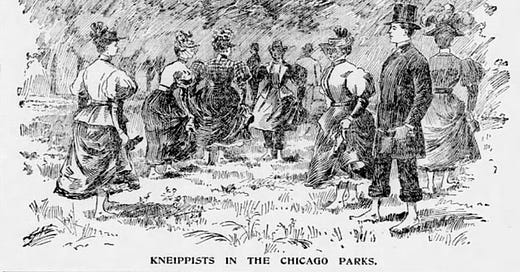There is an internet meme that’s meant to end arguments—you tell the person whose ideas you think are out of whack that they should “touch grass.” Sometimes you announce that it’s time for you to touch grass—turn the electronic devices off and make contact with the physical natural world.
It’s good advice—and, since there’s a push to return America to the 1890s in lots of not so great ways, it takes us back to an effort in the late 1890s of how to find health. I stumbled into it again while researching this week.
It was a whole system of thought called Kneippism and was touted as a way to cure all the ills people experienced in a country in all kinds of distress. There were five pillars: hydrotherapy, herbal medicine, exercise, diet, and mental balance by literally getting in touch with nature. As the Tribune snarked, the Kneippists thought it would cure them of “gout, sciatica, rheumatism, poor complexions, football limps, bicycle humps, unorthodox religious opinions, and the mistaken belief in their own importance.”
It all started with Father Sebastian Kneipp of Bavaria, who thought he cured himself of tuberculosis by taking ice cold baths in the Danube River. He also explored herbal remedies, but his cure probably had as much to do with a plant-based diet, daily exercise, and life in the mountains. It’s why New York State’s Adirondacks attracted TB sanitariums. He turned his ideas into a system, treated any who found their way to his monastery, from Archduke Franz Ferdinand and Pope Leo XIII to the poor, and then sold his name and likeness to an entrepreneur who made the ideas trendy, publishing a book in English in 1894.
The version of Kneippism that arrived in Chicago did not encourage plunges into icy cold Lake Michigan, no doubt because the lake was still badly polluted, so they had to settle for walking barefoot in dew-soaked grass at dawn, which was officially recommended.
Around 1895, the Kneippists started showing up in Chicago parks. Lincoln Park had a large contingent, but Hyde Park got into the act as well with its large expanses of grass. One contingent liked to show up in what was then known as East End Park on what was then the lakefront. This was particularly hazardous as it had been a place where a lot of “variegated rubbish” had been dumped. There might have been quite a bit of broken glass among the dewy grass.
In 1896, an intrepid Chicago Tribune reporter decided to check out the Kneippist scene one September morning at dawn. The middle and upper class Chicagoans who participated had a problem. It was not at all the polite thing to have naked feet in public. It was one thing to be among fellow Kneippists, but they did not like being observed.
One family complete with mother, father, and a gaggle of children, plumped down on the Midway grass, hiding their feet, and waited for him to leave, among a lot of giggling. A solitary man Kneipping by the German Building in Jackson Park glared at him stonily before going back to strolling along reading a newspaper, his shoes dangling from his shoulders by their tied laces and his socks sticking out of his box coat pockets.
The reporter observed there were gendered approaches. The men sauntered to the common, hastily removed his foot coverings and rolled up his trousers when no one was in sight, then took out reading material. If an observer was spotted, the man pretended to have lost something in the grass. Feminine Kneippists hid in the shrubbery to take off their stockings and shoes, then dropped their hems to hide their bare feet, breathless and blushing.
On the other hand, the wealthy women of Drexel Boulevard strolled unabashed in the beautifully landscaped median with their maids behind them, carrying their shoes. Bicycle girls giggled as they stacked bikes on the Midway, then giggled as they walked on the wet grass, giggled if seen, and giggled as they left.
By 7 AM the reporter discovered that all the Kneippists were gone. And by 1899, the fad was over—though there are still Alpine spas where you can go Kneipping. Of course, much later, after the Promontory Point was constructed, a whole new generation stumbled on the invigorating experience of plunging into the cold water of a now clean Lake Michigan at dawn.
A nice article about the Point swimmers:
https://www.newcity.com/2022/07/05/something-in-the-water-at-the-point-swimming-is-life/








Another great article. I just love the graphic from the book, especially the top pics with the hose and the washtub! Thanks for traveling down this rabbit hole, Trish!
Hyde Park: always ahead of its time!